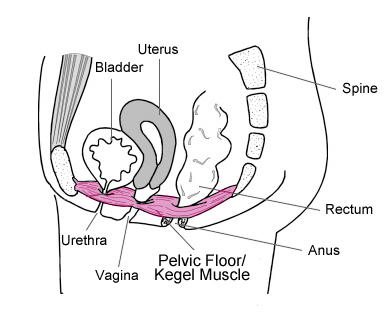
You might have heard of your 'pelvic muscle', your 'Kegel muscle' or your 'PC muscles', but did you know that your pelvic floor is not just a single muscle, rather a layer of muscles, fibres and ligaments that work together to support your pelvic organs and give you urogenital control.
Your Pelvic Floor Muscles
Your pelvic floor muscles, or 'Kegel muscles' are made up of three main layers of pelvic muscle:
The superficial group: This is the group of muscles that are found at the entrance to the vagina. This is the group that helps with sexual function and help you to control the bladder. After childbirth, these muscles can become weak. They can also weaken over time due to aging and the menopause.
The urogenital muscle group: This is the group of muscles that surround the urinary and genital muscles, and are responsible for bladder function.
The deep pelvic floor muscle group: This is called the levator ani, and extends from the pubic bone at the front, towards the coccyx at the back and the side walls towards the hips. It is a broad, thin group of muscles which is made up of 3 parts:
- The iliococcygeus muscle
- The pubococcygeus muscle
- The puborectalis muscle
This group of muscles is the main support for your pelvic floor, and provides a sort of 'hammock' for your pelvic organs, and forms a platform which helps to keep your pelvic organs in place. Pelvic floor muscles are also important for sexual function in men and women. It is important in men for erectile function and ejaculation and in women squeezing of the pelvic floor muscles is responsible for sexual sensation and arousal. In women our pelvic floor muscles provide support for the baby during pregnancy and assist in the birthing process. The pelvic floor muscles work with the core muscles of the abdomen and back muscles to stabilise and support the spine so they are vital for posture and support.
You should make exercising your Kegel muscles a part of your daily exercise routine. Dr Arnold Kegel published his clinical research in 1948 about the importance of pelvic exercise – but it seems as though women still don't realise how important it really is!
Did you know there is a good Kegel and a bad Kegel?

It's really important that you exercise the correct pelvic floor muscles in the correct way to make sure your pelvic floor is strong and healthy.
Kegel8 makes it easy!
When you exercise with a Kegel8 Ultra 20 Digital Pelvic Toner, you can be sure that you are giving your pelvic floor muscles the very best workout possible. When you do manual Kegel exercises correctly, you target around 40% of the pelvic floor, but a Kegel8 Pelvic Toner works around 90% of the pelvic floor, right down to the deepest layers of pelvic floor muscle.




